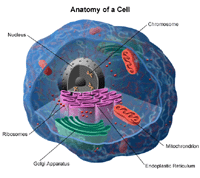What Are Chromosomes?
The human body is made up of cells. For example, when you have a sunburn and your skin peels, then you are shedding skin cells. In the center of each cell is an area called the nucleus. Human chromosomes are located inside the nucleus of the cell. A chromosome is a structure that holds your genes. Your genes determine your traits, such as eye color and blood type.
The usual number of chromosomes inside every cell of your body is 46 total chromosomes, or 23 pairs. You inherit half of your chromosomes from your biological mother, and the other half from your biological father.
Scientists have numbered the chromosome pairs from 1 to 22, with the 23rd pair labeled as X or Y, depending on the structure. The first 22 pairs of chromosomes are called autosomes. The 23rd pair of chromosomes are known as the sex chromosomes, because they decide if you will be born male or female. Females have two X chromosomes, while males have one X and one Y chromosome. A picture of all 46 chromosomes in their pairs is called a karyotype. A normal female karyotype is written 46, XX, and a normal male karyotype is written 46, XY.

Connect with us:
Download our App: